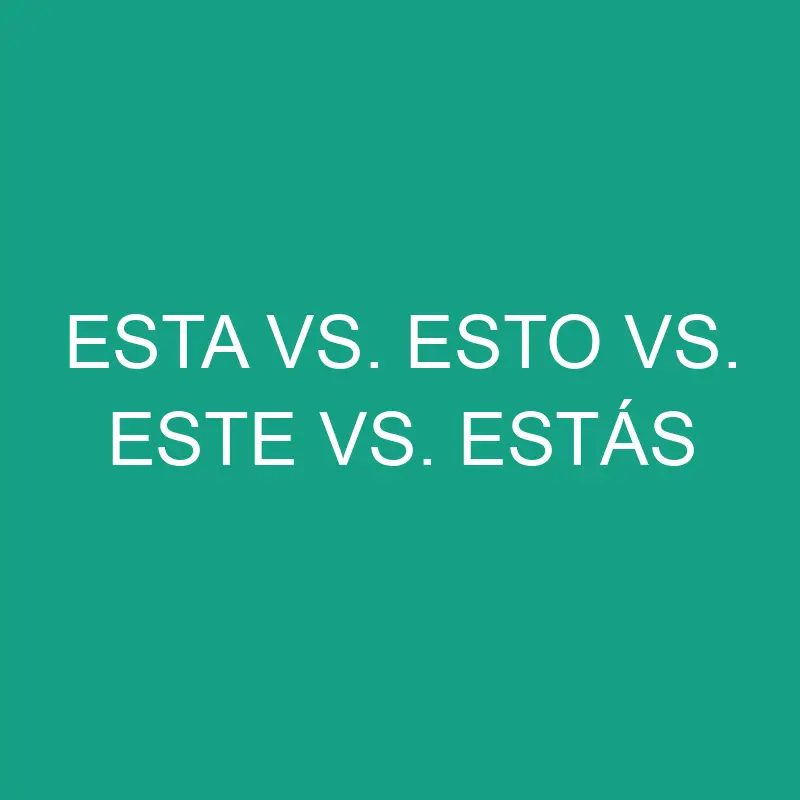Understanding Spanish Demonstratives:
In the rich tapestry of the Spanish language, nuances are embedded within its grammar and vocabulary. Among the aspects that can be initially perplexing for learners are demonstratives — words that indicate and specify nouns. In this exploration, we’ll delve into the distinctions between “esta,” “esto,” “este,” and “estás,” unraveling their meanings, applications, and how they contribute to the precision and beauty of the Spanish language.
Post Contents
Demonstrative Basics
Before delving into the specifics of “esta,” “esto,” “este,” and “estás,” let’s establish a foundational understanding of demonstratives in Spanish. Demonstratives are words used to point out or identify a specific noun or nouns. They agree in gender and number with the noun they modify. In Spanish, there are three sets of demonstratives: este (this), ese (that), and aquel (that over there), each with variations for gender and number.
1. Este (This)
– Gender and Number Agreement:
- “Este” is used with masculine singular nouns.
- “Esta” is used with feminine singular nouns.
- “Estos” is used with masculine plural nouns.
- “Estas” is used with feminine plural nouns.
– Example Sentences:
- Este libro (This book)
- Esta casa (This house)
- Estos perros (These dogs)
- Estas flores (These flowers)
– Proximity:
- “Este” is generally used for things that are close in proximity to the speaker.
– Temporal Use:
- “Este” can also be used to refer to the current time.
- Este verano (This summer)
2. Esta (This)
– Gender and Number Agreement:
- “Esta” is used with feminine singular nouns.
- “Estas” is used with feminine plural nouns.
– Example Sentences:
- Esta película (This movie)
- Estas sillas (These chairs)
– Proximity:
- Like “este,” “esta” is used for things that are close to the speaker.
– Temporal Use:
- It can also be employed in temporal contexts.
- Esta semana (This week)
3. Esto (This, This thing)
– Gender and Number Agreement:
- Unlike “este” and “esta,” “esto” does not change for gender or number.
– Example Sentences:
- Esto es interesante. (This is interesting.)
- No entiendo esto. (I don’t understand this/this thing.)
– General Use:
- “Esto” is a more general demonstrative and is often used when the noun being referred to is unclear or unspecified.
– Abstract Concepts:
- It is commonly used for abstract concepts.
- Esto es la vida. (This is life.)
4. Estás (You Are)
– Gender and Number Agreement:
- “Estás” is a form of the verb “estar” conjugated for the second person singular (tú).
– Example Sentences:
- Estás cansado. (You are tired.)
- Estás feliz. (You are happy.)
– Not a Demonstrative:
- It’s important to note that “estás” is not a demonstrative, but it often appears in discussions about demonstratives due to its phonetic similarity.
– Verb Use:
- “Estás” is used to describe a temporary state or condition.
Comparative Analysis
– Este vs. Esta:
- The key distinction lies in the gender of the noun being referred to. “Este” is for masculine nouns, and “esta” is for feminine nouns.
– Este vs. Esto:
- “Este” refers to a specific masculine singular noun, while “esto” is more general and can refer to a thing or an abstract concept.
– Esto vs. Estás:
- “Esto” is a demonstrative pronoun or neuter demonstrative, while “estás” is a form of the verb “estar” indicating the second person singular.
– Esto vs. Estos:
- “Esto” is singular and gender-neutral, while “estos” is plural and masculine.
Conclusion
In the intricate dance of language, demonstratives add a layer of specificity and clarity. “Este,” “esta,” “esto,” and “estás” play distinct roles in the Spanish language, enabling speakers to pinpoint, identify, and communicate with precision. Understanding their applications not only enhances linguistic proficiency but also opens a gateway to the cultural nuances embedded in the language.
As learners navigate the landscape of Spanish, grappling with the intricacies of demonstratives is a significant step towards mastery. From the tangible proximity denoted by “este” and “esta” to the broad inclusivity of “esto,” and the temporal context woven by “estás,” each term contributes to the rich fabric of expression that is the Spanish language. So, whether you are pointing to a specific book with “este libro,” contemplating the abstract with “esto es la vida,” or describing a temporary state with “estás cansado,” these demonstratives are your linguistic companions, guiding you through the nuanced terrain of Spanish communication. ¡Buena suerte! (Good luck!)
